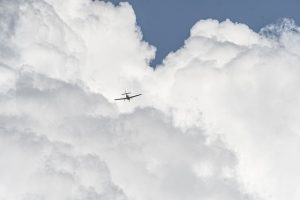
Banked turns are a common flight maneuver in the aviation world. When pilots need to change the heading of an airplane, they will perform this maneuver. Airplanes don’t turn like cars and other land-based vehicles. Instead, they “bank.” For a better understanding of banked turns in aviation, keep reading.
Overview of Banked Turns
A banked turn is a slight maneuver that involves tilting or “banking” an aircraft to the side. As previously mentioned, it’s used to change the heading of an airplane. Pilots can change the direction in which the airplane is flying by performing a banked turn.
Lift counters the airplane’s weight at level flight, which makes it difficult to change the heading simply by turning. Banked turns offer a solution. They redirect lift to help airplanes move to the side. Banked turns involve tilting the wings — one wing goes up and the other wing goes down — which allows the airplane to roll to the side. This tilting shifts some of the lift sideways, thereby creating a pulling force that allows the airplane to turn more easily and with less resistance.
How Pilots Perform Banked Turns
Pilots can perform banked turns by adjusting the airplane’s ailerons. This is typically done by moving a control stick or yoke in the cockpit.
Pilots will also use the rudder when performing banked turns. The rudder controls the yaw. It’s used to turn the airplane’s nose. If there’s too little or too much yaw, the airplane may slip during a banked turn. Adjusting the rudder in conjunction with the control stick or yok allows for a smoother banked turn.
Banked turns often result in a loss of altitude. After all, they involve tilting the airplane to the left or right. Therefore, pilots may change the airplane’s angle of attack to compensate for this slight loss of altitude.
The final step to performing a banked turn is rolling the airplane back to level flight. This is typically done by adjusting the ailerons and rudder.
Banked Turns vs Coordinated Turns
It’s a common assumption that banked turns and coordinated turns are the same. While they are both used to change the heading of an airplane, they are two different flight maneuvers.
A banked turn involves tilting the airplane to the side. The airplane’s wings essentially tilt in the direction of the turn. A coordinated turn, on the other hand, is a flight maneuver that involves banking while maintaining the airplane’s flight path. The pilot essentially aligns the airplane’s nose with the flight path.



